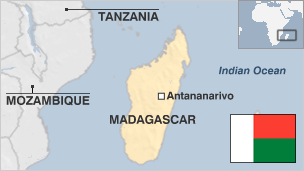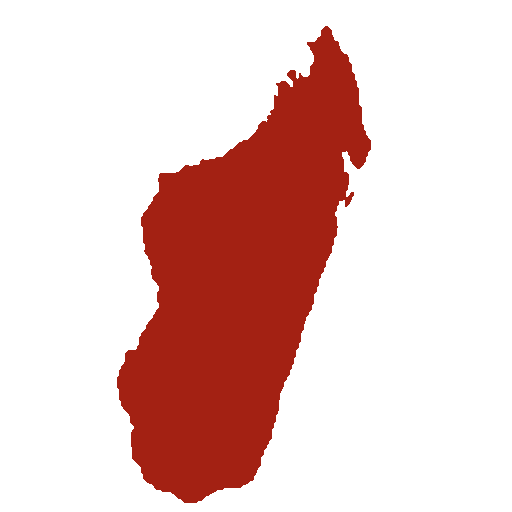 Madagascar is the fourth-largest island in the world and is located nearly 350 miles off the south-east coast of Africa. Of course, many people know of the cartoon movies with the name “Madagascar”, but other than that, Madagascar is most well known for its great biological diversity, as the majority of its plant and animal species are found nowhere else on earth. The most famous of its animals are lemurs (living only in Madagascar) and chameleons. Madagascar is also well known for baobab trees. Many of Madagascar’s plants and animals hold one record or another for biggest, smallest, etc.
Madagascar is the fourth-largest island in the world and is located nearly 350 miles off the south-east coast of Africa. Of course, many people know of the cartoon movies with the name “Madagascar”, but other than that, Madagascar is most well known for its great biological diversity, as the majority of its plant and animal species are found nowhere else on earth. The most famous of its animals are lemurs (living only in Madagascar) and chameleons. Madagascar is also well known for baobab trees. Many of Madagascar’s plants and animals hold one record or another for biggest, smallest, etc.
People first settled in Madagascar around 1500-2000 years ago and are descended mostly from Indonesians but many people along the coasts also have a strong African heritage, with some northern Malagasy also having Arab descent. Around 1000 years ago, small groups of Arabs established trading posts on the northwest coast. Europeans first encountered Madagascar in 1500 and France colonized Madagascar in 1895. However, the colonization was light and French rule ended and Madagascar gained independence in 1960. Today there are about 22 million people living in Madagascar and unfortunately it’s becoming too many people for the agriculture of the island to easily support.
The national languages of Madagascar are Malagasy and French and English has recently been introduced in school. However, the majority of Malagasy people speak only Malagasy (and often only their specific dialect of it). The Malagasy language is most closely related to an Indonesian dialect, so it’s very much unlike languages in mainland Africa. There are around 18 different ethnic groups in Madagascar. There are also as many dialects of Malagasy spoken throughout the island. Tribal groups living in the same area can usually understand each other, but those living further apart usually cannot. This makes learning the dialect of each group to be reached essential to reaching them.
Because of their Southeast Asian heritage, Malagasy culture shares many things in common with them. In particular, the staple food in Madagascar is rice, and Madagascar has one of the highest per capita rates of rice consumption in the world. Rice is usually eaten with any number of side dishes known as “laoka” or “kabaka”.
Malagasy traditional religion places a strong importance on the veneration, or worship, of their ancestors. To many traditional Malagasy people, they call on their ancestors to bless them and their family or they suspect their ancestors of cursing them if/when something bad happens. Any taboos (“fady”) their ancestors created are required to be followed by all the generations after them. In many areas, their ancestors’ bodies are even taken out of their tombs in elaborate rituals to celebrate and appease them. Statistically, Malagasy people are 41% Christian and 52% hold traditional beliefs. The majority of Christians in Madagascar are located in the central highlands, though Christian churches can be found in most urban areas of Madagascar. However, a large number of the 41% Christian also blend their traditional religion with Christianity, combining them in such a way that their ancestors are still feared and worshiped. According to some reports, as much as 50% of the population has never heard the Good News of Jesus. Most of those people are living in hard-to-reach rural areas.
More than 75% of Malagasy people still live in rural villages, many of which can only be reached by footpath, bicycle trail, or river. Most Malagasy people survive by farming, rice foremost, but other crops as well. Unfortunately, many of the farming methods aren’t sustainable in the long run and are quickly depleting the country’s natural resources. On top of that, recent cyclones, droughts, and floods have made crop harvests much worse than usual. Over 75% of the population live on less than $1 a day, as most of their livelihood is subsistence farming.
Recent political upheavals in Madagascar have only made the economic situation worse for most Malagasy people and Madagascar now tops the list for world’s worst economies. Government educational spending has ended entirely and medical spending has been reduced to only $2 per person. As the price of rice is continuing to increase at a rapid rate, it’s becoming harder and harder for Malagasy people to stay well-fed. Unfortunately, it doesn’t look like things will be improving in that area any time soon.
That’s why the work that we do with YWAM is so important. We’re going to some of the most remote parts of Madagascar and introducing them to the God who sets them free to live abundantly. We’ve helped bring development projects such as villager-led clinics, health and sanitation education, and micro-businesses. Our goal is to start and participate in a self-propagating movement of church-planting and sustainable community development, reaching every sphere of society and spreading throughout Madagascar, especially the still untouched rural areas where the majority of Malagasy people live. Please pray for the people of Madagascar, and pray for us as we work with them.
Additional Reading:
Lonely Planet: Introducing Madagascar
CIA World Factbook: Madagascar
BBC: Madagascar profile
Madagascar on Wikipedia
An interesting article on the Malagasy language on Wikipedia
Madagascar: A poor country gets poorer
Madagascar water supply: only 44% have access to drinking water
Madagascar: Sentenced to Malnutrition

Trackbacks/Pingbacks